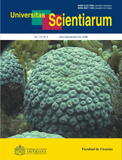Abstract
Se llevó a cabo la evaluación del cultivo de Pleurotus ostreatus, para determinar el residuo sobre el cual este hongo genera mejor crecimiento y producción. Los sustratos evaluados fueron residuos agroindustriales del departamento de Cundinamarca (capacho de uchuva, cáscara de arveja y tusa de maíz); teniendo como sustrato control el aserrín de roble. Las mezclas a evaluar fueron empacadas en bolsas de 1Kg de volumen de mezcla de sustrato, del cual el 78% fue el residuo agroindustrial. Se esterilizaron e inocularon con 30g de semillas de Pleurotus ostreatus, adquiridas comercialmente. Se evaluó el tiempo de corrida del micelio, el diámetro de los carpóforos, el número de hongos producidos por bolsa, el peso fresco, la eficiencia biológica y el rendimiento de cada uno de los sustratos trabajados. Finalmente, el mejor sustrato para el crecimiento y producción de Pleurotus ostreatus fue el capacho de uchuva ya que alcanzó una eficiencia biológica de 76.1% en un período total de producción de 41 días y una rentabilidad de 39.03 Kg/m2 con excelentes características organolépticas, considerándose así un sustrato adecuado y eficiente para el cultivo de este hongo.
Palabras clave: Carpóforo, Fructificación, Pleurotus ostreatus, residuos agroindustriales, sustratos.
Abstract
The culture of Pleurotus ostreatus was evaluated to determine the best waste on which this mushroom can show the highest growth and production rates.. The substrates evaluated were agroindustrial wastes of the Department of Cundinamarca (dry skin of goldenberries (Physalis), skin of pea pods and maize cobs). The control substrate was sawdust of oak. The mixtures evaluated were packed in bags of 1 kg containing 78 % of
agroindustrial waste of the volume of substrate mixture . Mixtures were sterilized and inoculated with 30 g of seeds of Pleurotus ostreatus obtained commercially. Running time of the mycelium, diameter of fruit bodies, number of fruit bodies produced per bag, fresh weight, biological efficiency, and yield were evaluated on each of the substrates. Finally, the best substrate for the growth and production of Pleurotus ostreatus was the dry skin of goldenberries (Physalis) with a biological efficiency of 76.1% after a total production period of 41 days and a yield of 39.03 Kg/m2 with excellent organoleptic characteristics, therefore being an adequate and efficient substrate for cultivating this mushroom.
Key words: Fructification, Fruit bodies, Pleurotus ostreatus, agroindustrial wastes, substrates
Univ. Sci. is registered under a Creative Commons Attribution 4.0 International Public License. Thus, this work may be reproduced, distributed, and publicly shared in digital format, as long as the names of the authors and Pontificia Universidad Javeriana are acknowledged. Others are allowed to quote, adapt, transform, auto-archive, republish, and create based on this material, for any purpose (even commercial ones), provided the authorship is duly acknowledged, a link to the original work is provided, and it is specified if changes have been made. Pontificia Universidad Javeriana does not hold the rights of published works and the authors are solely responsible for the contents of their works; they keep the moral, intellectual, privacy, and publicity rights. Approving the intervention of the work (review, copy-editing, translation, layout) and the following outreach, are granted through an use license and not through an assignment of rights. This means the journal and Pontificia Universidad Javeriana cannot be held responsible for any ethical malpractice by the authors. As a consequence of the protection granted by the use license, the journal is not required to publish recantations or modify information already published, unless the errata stems from the editorial management process. Publishing contents in this journal does not generate royalties for contributors.



